Here's when to choose devil's claw or arnica products
Arnica and devil's claw are two well-known herbs in natural medicine, so much so that many people use products made from these plants as an aid against neck, back and joint pain and many other problems.
But is it better to use arnica or devil's claw? Are they equivalent remedies or not?
In this article, we will explore the active ingredients, benefits and uses of both plants, and compare them so that you know when to choose one over the other.
What is arnica and what are its benefits?
Arnica montana is a herb belonging to the Compositae family (also called Asteraceae) that has been used since the 16th century to reduce pain and inflammation.
The stem can reach a height of about sixty centimetres, and the daisy-like flowers are bright yellow.

In nature, it grows mainly in the mountainous areas of Europe - in fact, it is called the 'mountain daisy' - but nowadays, its cultivation is particularly widespread in order to make full use of the flowers' therapeutic properties.
Arnica flowers are rich in functional active ingredients, e.g. flavonoids, polyphenols, carotenoids, sesquiterpene lactones and many other substances.
Many of these components interact with our organism, bringing numerous benefits. In particular, thanks to them, arnica has the following properties:
- anti-inflammatory
- pain-relieving
- antioxidant
- protective of microcirculation
- revulsive
Read the following article to learn more: Arnica: what it is, what it is used for and what are its properties
The uses of Arnica Montana
Numerous products are made from arnica flower extracts and water, including arnica gel, creams, oils and sprays.
Several studies (such as the following: Clinical Trials, Potential Mechanisms, and Adverse Effects of Arnica as an Adjunct Medication for Pain Management) have successfully tested the use of preparations for cutaneous use against muscle and even joint pain.
In the course of the research, the continued use of arnica products was found to be particularly effective against back pain, neck pain, muscle strains, contusions, swellings, bruises (bruises) and joint pain.
It is also possible to find homeopathic products for oral use based on extracts of the plant on the market, but their efficacy is doubtful.
In fact, arnica, if ingested, is toxic to the organism: products for oral use may contain its extracts, but only if they are abundantly diluted, thus detracting from the product's effects.
Let us now see what devil's claw is and what its uses are.
What is devil's claw?
Devil's claw (Harpagophytum procumbens) is a perennial plant that grows mainly in western and southern Africa. It gets its very distinctive name from the shape of its sharp purple fruits, which resemble hooks.
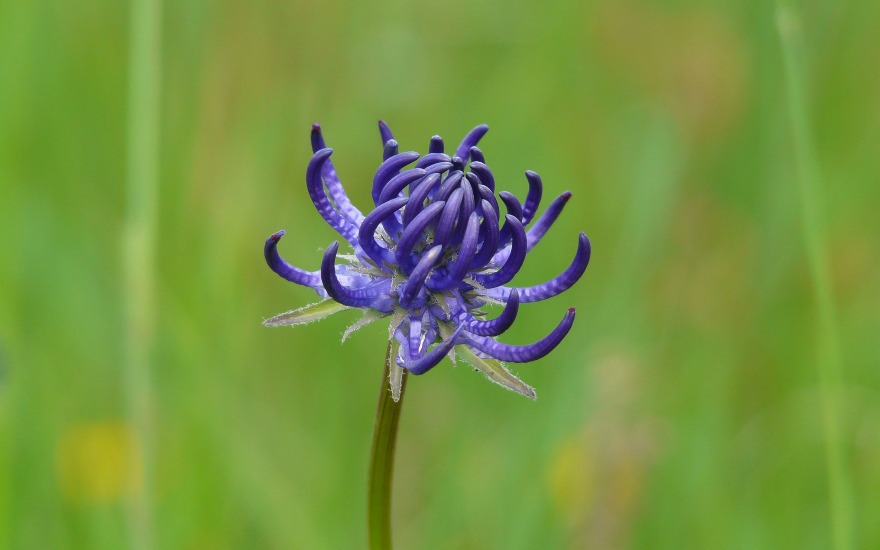
Parts of the plant, such as the roots, are rich in flavonoids, triterpenes and phytosterols, substances with anti-inflammatory, pain-relieving and antioxidant properties.
For this reason, devil's claw has been used for centuries in traditional African medicine against numerous joint, muscle and even digestive problems, but its use and cultivation is now widespread throughout the world.
Benefits and uses of devil's claw
Devil's claw extracts are mainly used to produce dietary supplements and preparations for skin use, such as gels, creams and ointments.
Specifically, supplements based on this plant are intended for the function of joints and the digestive system.
For example, many people take devil's claw supplements as a natural anti-inflammatory against pain caused by arthritis and osteoarthritis or to aid digestion.
Devil's claw gels, like creams and other topical products, on the other hand, are very popular for relieving joint and muscle pain. It seems that applying these products to the affected areas helps reduce discomfort and tension.
But which product to choose between arnica and devil's claw?
Arnica or devil's claw: which one to use according to the different problems?
Both plants are rich in anti-inflammatory and pain-relieving active ingredients, but there are differences.
Arnica is recommended as an aid against the following problems:
- hematomas and bruises
- sprains
- contusions
- back pain
- muscle cramps and strains
- DOMS, the delayed-onset muscle soreness typical of intense exercise
- oedema, the accumulation of fluid in interstitial tissues
- skin discomfort, including insect bites
In addition, many people use arnica gels and creams to warm up their muscles before exercise and to relieve them after sport.
Devil's claw, on the other hand, is particularly useful for:
- joint pain
- joint swelling and stiffness, also caused by diseases such as arthrosis
- back pain
- neck pain (cervicalgia)
- tendonitis
- sciatica
And, more generally, for chronic inflammation.
Thus, arnica is particularly useful in cases of trauma, unlike devil's claw, which is more suitable for chronic, but not traumatic inflammation and problems.
In conclusion, we cannot say which plant is better between arnica and devil's claw: both can be used according to the body's needs.
Sources:
Monica L Andersen, Eduardo H.R Santos, Maria de Lourdes V Seabra, Ana A.B da Silva, Sergio Tufik,
Evaluation of acute and chronic treatments with Harpagophytum procumbens on Freund's adjuvant-induced arthritis in rats, Journal of Ethnopharmacology, Volume 91, Issues 2-3, 2004, Pages 325-330, ISSN 0378-8741, https://doi.org/10.1016/j.jep.2004.01.003.
Smith AG, Miles VN, Holmes DT, Chen X, Lei W. Clinical Trials, Potential Mechanisms, and Adverse Effects of Arnica as an Adjunct Medication for Pain Management. Medicines (Basel). 2021 Oct 9;8(10):58. doi: 10.3390/medicines8100058. PMID: 34677487; PMCID: PMC8537440.
Wegener T, Lüpke NP. Treatment of patients with arthrosis of hip or knee with an aqueous extract of devil's claw (Harpagophytum procumbens DC.). Phytother Res. 2003 Dec;17(10):1165-72. doi: 10.1002/ptr.1322. PMID: 14669250.
Kriplani P, Guarve K, Baghael US. Arnica montana L. - a plant of healing: review. J Pharm Pharmacol. 2017 Aug;69(8):925-945. doi: 10.1111/jphp.12724. Epub 2017 Apr 11. PMID: 28401567.
Menghini L, Recinella L, Leone S, Chiavaroli A, Cicala C, Brunetti L, Vladimir-Knežević S, Orlando G, Ferrante C. Devil's claw (Harpagophytum procumbens) and chronic inflammatory diseases: A concise overview on preclinical and clinical data. Phytother Res. 2019 Sep;33(9):2152-2162. doi: 10.1002/ptr.6395. Epub 2019 Jul 4. PMID: 31273865.
Here’s when to choose devil’s claw or arnica products Arnica and devil’s claw are two well-known herbs in natural medicine, so much so that many people use products made from these plants as an aid against neck, back and joint pain and many other problems. But is it better to use arnica or devil’s claw? […]
Definition, properties and benefits of Diosmin.
Diosmin is a herbal substance first isolated in 1925. Nowadays, it is often recommended in the form of microcirculation supplements, creams and ointments, with the aim of boosting your blood circulation and alleviating specific problems.
But what exactly is it, what is it used for and in what forms can it be taken?
What is diosmin and where can it be found in nature?
Diosmin is a natural compound that belongs to the class of bioflavonoids (also known as flavonoids), plant substances that exert several beneficial activities on the body thanks to their antioxidant, anti-inflammatory and microcirculatory protective actions.
In nature, we find large concentrations of this flavonoid mainly in citrus fruits, notably oranges, grapefruits and tangerines, as well as in certain shrubs, such as Ruta graveolens and Barosma betulina.
Since the late 1960s, diosmin has been widely used as a therapeutic remedy against numerous problems, including haemorrhoids, swollen legs, varicose veins and many others.
Benefits and properties
Bioflavonoids are the subject of constant research because of their many positive effects on the human organism.
In particular, numerous studies have confirmed the benefits of diosmin,, which is effective not only as an antioxidant and anti-inflammatory but also as an anti-hyperglycaemic, anti-mutagenic and anti-ulcer. (Huwait E, Mobashir M., Potential and Therapeutic Roles of Diosmin in Human Diseases).
Further research suggests that diosmin reduced to extremely small micrometre-sized fragments (a process known as micronization), has a positive effect on microcirculation, lymphatic drainage and, indirectly, on the venous tone. (Venoactive Drugs, Chapter 14, Albert-Adrien Ramelet).
Below are a few details on the main properties of diosmin:
- Antioxidant action: this bioflavonoid has proven effective in helping neutralise free radicals and reducing oxidative stress in the body, an alteration that causes several damages (including premature ageing of the cells).
- Anti-inflammatory action: when the human body experiences inflammation, which can be detected by appropriate blood tests measuring the levels of the so-called inflammatory markers, diosmin is believed to lower the level of these markers thanks to its anti-inflammatory effects.
- Beneficial action on microcirculation, lymphatic drainage and venous tone: Diosmin contributes to protecting microvascular permeability (microcirculation involves arterioles, metarterioles, capillaries and venules), improving the lymphatic flow, reducing the diameter of lymphatic vessels and intra-lymphatic pressure and boosting venous tone by prolonging the action of a particular hormone called noradrenaline.
In addition, diosmin is used together with other flavonoids, such as hesperidin, to enhance the therapeutic effects and counteract a wide range of problems.
How to use diosmin: what is it used for and how to integrate it
The benefits of diosmin make it an ideal ingredient for products for external use, such as ointments, creams or gels to be applied directly to the skin, as well as for products for internal use, such as supplements and medicines.
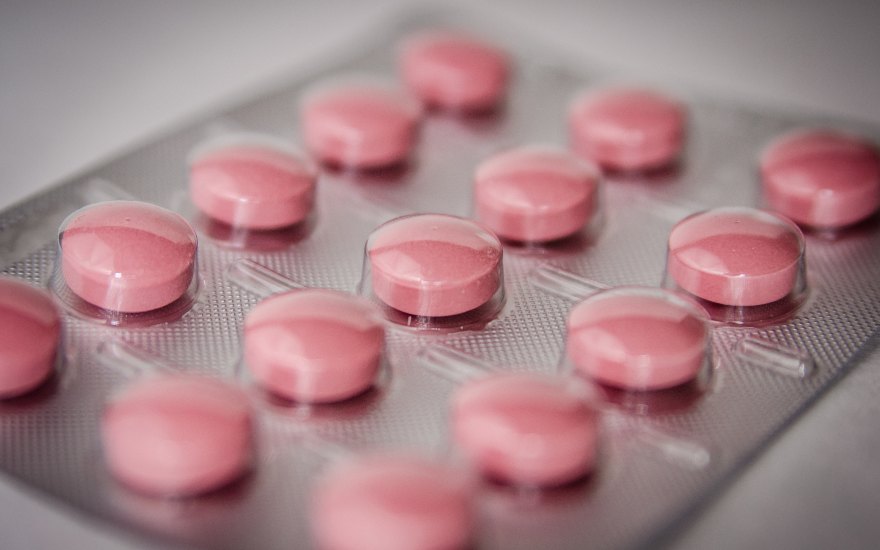
These preparations are mainly recommended against haemorrhoids, varicose veins, capillary fragility, swollen legs, water retention and cellulite.
The most common diosmin products include:
- Medications and supplements for microcirculation, haemorrhoids and lymphatic drainage based on micronised diosmin (often combined with other flavonoids and extracts such as hesperidin, butcher's broom and horse chestnut), such as Diosmin Expert Omniven 500.
- Gels and creams for swollen, heavy legs and fragile capillaries, to be applied with a gentle massage to promote absorption of the active ingredient.
- Creams and ointments for haemorrhoids, which can alleviate haemorrhoidal disorders and reduce itching and swelling.
- Creams for dark circles and couperose, which may help reduce the problem.
How to integrate diosmin in case of need
In cases of poor microcirculatory function, supplements based on diosmin and hesperidin (in tablets containing 450 mg of diosmin and 50 mg of hesperidin) are often recommended.
Even though it is the doctor who should determine how long to take the supplement, the period should generally not exceed 3 months and the recommended dosage is one or two 500 mg tablets per day.
To increase the intake of this flavonoid, it is also advisable to look after one’s diet. As mentioned above, diosmin is present in numerous fruits belonging to the Citrus genus, better known as as citrus fruits.
Green light, therefore, to oranges, lemons, grapefruits and mandarins, especially if they are fresh, in season and untreated.
Contraindications, side-effects and possible interactions with other substances
Possible side-effects caused by taking diosmin, although very rare, encompass abdominal pain, gastric pain, diarrhoea and headaches.
There are no particular contraindications to taking the active substance, but some studies (including Pharmacokinetic interaction of diosmetin and silibinin with other drugs, Poór M, Boda G, Mohos V, Kuzma M, Bálint M, Hetényi C, Bencsik T) suggest that it might interact with anticoagulants, anticonvulsants and anti-inflammatory drugs.
Indeed, it appears that the flavonoid may reduce the absorption of the active ingredients of these drugs. It is therefore advisable to seek advice from your doctor before taking diosmin supplements or medicines.
Is diosmin really beneficial?
The numerous in vitro and in vivo studies carried out on diosmin have demonstrated its beneficial effects on the body, including its antioxidant, anti-inflammatory and positive effect on microcirculation.
Of course, before taking any dietary supplement - including flavonoid supplements - it is a good idea to consult your doctor so as to avoid any interactions with other substances, such as drugs or other supplements.
Sources:
Venoactive Drugs (Albert-Adrien Ramelet, Chapter 14 - Venoactive Drugs, Editor(s): Mitchel P. Goldman, Jean-Jérôme Guex, Robert A. Weiss, Sclerotherapy (Fifth Edition), W.B. Saunders, 2011, Pages 369-377, ISBN 9780323073677, https://doi.org/10.1016/B978-0-323-07367-7.00020-0)
Pharmacokinetic interaction of diosmetin and silibinin with other drugs (Poór M, Boda G, Mohos V, Kuzma M, Bálint M, Hetényi C, Bencsik T. Pharmacokinetic interaction of diosmetin and silibinin with other drugs: Inhibition of CYP2C9-mediated biotransformation and displacement from serum albumin. Biomed Pharmacother. 2018 Jun;102:912-921. doi: 10.1016/j.biopha.2018.03.146. Epub 2018 Apr 5. PMID: 29710546)
Featured Image: Background vector created by WangXiNa - it.freepik.com
Disclaimer: The information provided in this article represents general indications and in no way replaces medical advice.
Definition, properties and benefits of Diosmin. Diosmin is a herbal substance first isolated in 1925. Nowadays, it is often recommended in the form of microcirculation supplements, creams and ointments, with the aim of boosting your blood circulation and alleviating specific problems. But what exactly is it, what is it used for and in what forms […]
We find it as an ingredient in creams, gels and oils. It has been used in homeopathic medicine for centuries, and many sportspeople use it regularly. But what is arnica and why is there so much talk about it when it comes to muscle tension and bruises?
Definition of arnica montana
Arnica (scientific name: Arnica Montana L.), is a perennial plant native to the mountains of Europe and North America and cultivated in various parts of the world.
The stem, which can reach a height of 1-2 metres, has bright green leaves and very fragrant bright yellow flowers.
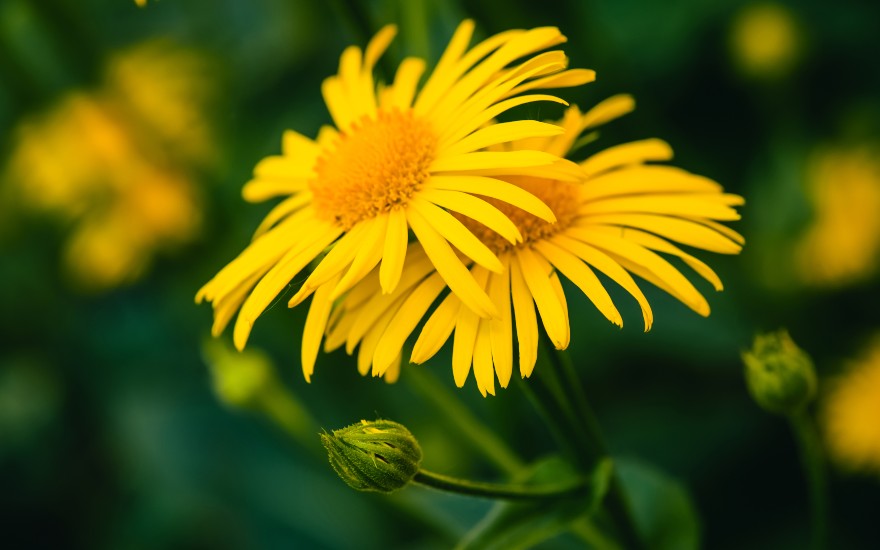
But, besides being known for its beauty and scent, the arnica flower is considered to be rich in active ingredients that are beneficial to the human organism.
It is therefore no coincidence that it is widely used in the form of extracts for the production of gels, creams, oils and homeopathic remedies that many people use to ease aches and muscle tension.
Properties and benefits
The arnica plant, and especially its flower, is rich in active substances such as sesquiterpene lactones, flavonoids, essential oils and polysaccharides.
Thanks to some of these components, arnica is thought to have analgesic, anti-inflammatory, anti-oedematous, antioxidant and revulsive properties that have been investigated and confirmed by multiple in vitro and in vivo studies.
Below are details regarding the beneficial properties of arnica:
- analgesic (pain-relieving), thanks to its high concentration of sesquiterpenes. This property is mainly harnessed for topical use of the product that must be applied directly on the affected area;
- anti-inflammatory and anti-oedematous, thanks to the presence of flavonoids and helenalin, a sesquiterpene lactone capable of inhibiting the NF-kB transcription factor. This factor is involved in the inflammatory processes of the human body and various inflammatory drugs and preparations purposely act by inhibiting its production;
- antioxidant and protective of the microcirculation due to the high concentration of flavonoids. These natural substances protect and strengthen microcirculation (involving arterioles, metarterioles, capillaries and venules) and help improve lymphatic drainage;
- revulsive, i.e. capable of stimulating blood flow to the surface layers of the skin. The revulsive effect can be useful in cases of inflammation, bruising and as a decongestant.
Let's now see in more details what arnica is used for and how to make the most of the benefits this medicinal plant provides.
What is arnica good for?
Arnica flowers, and sometimes also the rhizome and roots, produce extracts that are widely employed in cosmetics, homeopathy and veterinary medicine.
Arnica concentrations are often combined with extracts of other plants having similar properties, such as eucalyptus, devil's claw and menthol.
Products used as a natural remedy for muscle pain, contractures, post-operative haematomas, bruises (also in children) and even insect bites are commonly developed from these extracts.
Specifically aimed at this purpose are some cosmetic products like arnica creams, ointments, oils, sprays and gels, to be applied with a massage directly on the area affected by pain, stiffness, swelling or bruising, but never on open wounds.
Authorised homeopathic remedies include a wide range of tablets, patches, granules and supplements, while the most popular animal product is arnica gel for horses, generally used to massage the muscles and joints of racehorses.
Arnica products have a very wide field of application. Here are a few examples:
- A large number of sportspeople use arnica in cream and gel form to both warm up their muscles before exercising and relax fatigued areas after exercise. The most sought-after product in these cases is arnica gel as its concentration of extracts is usually higher than in other products;
- many people use arnica-based gels, creams, oils or ointments to soothe pain in the neck, muscles, tendons and joints;
- arnica is also used in the post-operative period to help absorb swelling and ecchymosis (bruising);
- numerous professionals - in the field of physiotherapy, massage, massotherapy etc. - use arnica montana products to perform relaxing and decontracting massages on their patients.
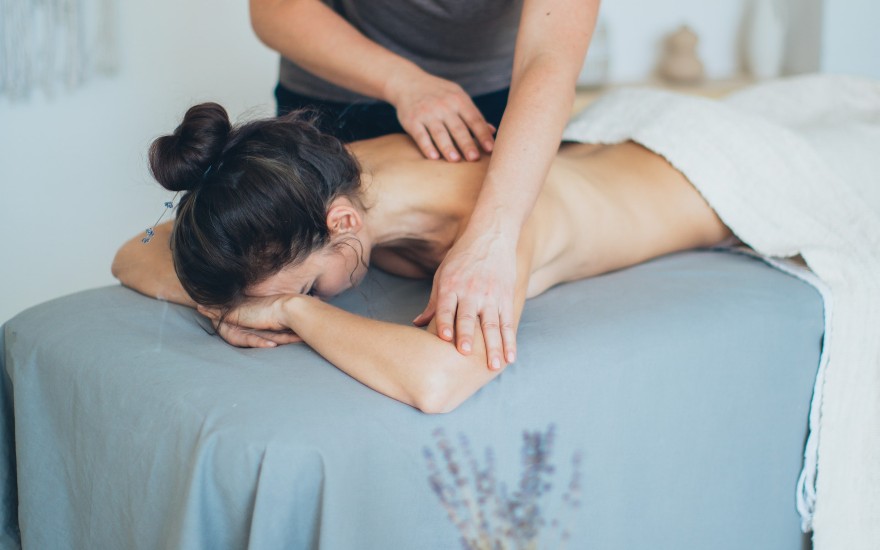
However, never rely on the preparation of do-it-yourself remedies, especially for internal use, as ingesting this plant can have very serious side effects.
Side-effects and contraindications
When taken for internal use, improperly diluted arnica can prove toxic to the body, particularly the liver. It is therefore extremely important to only use commercially available products and avoid home-made solutions (the so-called 'grandmother's remedies').
Taking homeopathic remedies based on this plant may reduce the effectiveness of anticoagulant, antithrombotic and low molecular weight heparin medications.
Furthermore, it is not recommended to use arnica products, even for topical use, if you are allergic to the plant.
Is arnica really effective?
The anti-inflammatory, analgesic, revulsive and antioxidant properties of arnica have been investigated in numerous studies, often with positive outcome when carried out on products for external use with a high concentration of extracts.
It is therefore no coincidence that so many people regularly use creams and gels based on extracts of this plant, as they consider them valuable allies in cases of muscle tension and contractures.
As much research has been carried out on homeopathic products, but with less promising results. One hypothesis is the following: as the extracts are highly diluted in these preparations (so that people can ingest them without the risk of intoxication), their effect proves extremely poor.
Even though the result of the research conducted on the properties of this plant have been proven, the effectiveness of arnica may depend on its concentration in the product.
Sources:
Smith AG, Miles VN, Holmes DT, Chen X, Lei W. Clinical Trials, Potential Mechanisms, and Adverse Effects of Arnica as an Adjunct Medication for Pain Management. Medicines (Basel). 2021 Oct 9;8(10):58. doi: 10.3390/medicines8100058. PMID: 34677487; PMCID: PMC8537440
Kriplani P, Guarve K, Baghael US. Arnica montana L. - a plant of healing: review. J Pharm Pharmacol. 2017 Aug;69(8):925-945. doi: 10.1111/jphp.12724. Epub 2017 Apr 11. PMID: 28401567
Ekenäs C, Zebrowska A, Schuler B, Vrede T, Andreasen K, Backlund A, Merfort I, Bohlin L. Screening for anti-inflammatory activity of 12 Arnica (Asteraceae) species assessed by inhibition of NF-kappaB and release of human neutrophil elastase. Planta Med. 2008 Dec;74(15):1789-94. doi: 10.1055/s-0028-1088320. Epub 2008 Oct 30. PMID: 18975264
Disclaimer: The information provided in this article represents general indications and in no way replaces medical advice.
We find it as an ingredient in creams, gels and oils. It has been used in homeopathic medicine for centuries, and many sportspeople use it regularly. But what is arnica and why is there so much talk about it when it comes to muscle tension and bruises? Definition of arnica montana Arnica (scientific name: Arnica […]
Information and details on bioflavonoids and their intake
Flavonoids, or bioflavonoids, are the key active ingredients of many microcirculation supplements and antioxidant products.
These particular compounds of plant origin are isolated in order to exploit their beneficial properties for the human organism.
In the course of this article, we will see what natural flavonoids are, where to find them and what the advantages (and possible disadvantages) of their supplementation are.
What are flavonoids and where are they found?
Flavonoids are a family of natural compounds found in the plant world and widely used in the pharmaceutical and cosmetic fields.
Specifically, they belong to a class of plant secondary metabolites with a polyphenolic structure and can be subdivided into six main subtypes: flavones, chalcones, isoflavonoids, flavanones, anthoxanthins and anthocyanins.
In nature, these compounds are found in fruits, vegetables and some of their derivatives. Here are the main foods rich in flavonoids:
- tea
- onions
- cabbage
- grapes (and red wine)
- berries (e.g. blackberries, raspberries, blueberries, currants, wild strawberries)
- strawberries
- apples
- peaches
- citrus fruit
- lettuce
- broccoli
- tomatoes
- cocoa (and its derivatives, such as dark chocolate)
- camomile
- parsley
- peppermint
- red peppers
- coffee
- soya
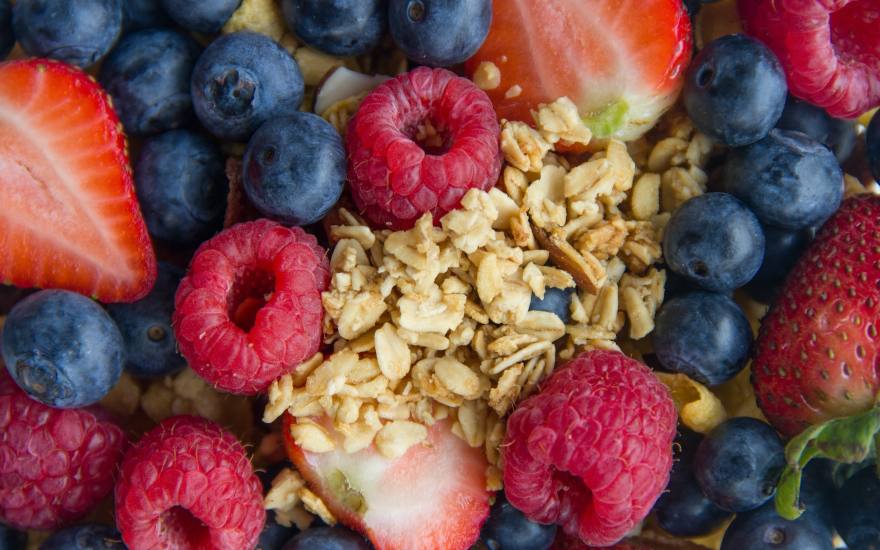
Although they are mainly known for their antioxidant (anti-free radical) action, bioflavonoids have many other properties and are vital for the well-being of the human body.
One of the main flavonoids is the diosmin, in which the best supplements for microcirculation are rich. To learn more, read the in-depth article "Diosmin: what is it, what is it used for and what are its benefits?"
All the benefits of flavonoids and their intake
Flavonoids have antioxidant, anti-inflammatory, anticarcinogenic and antimutagenic properties (i.e. they prevent genetic mutation of cells and all the risks related to this alteration).
Some of them, in particular diosmin and hesperidin, also have a protective action on microcirculation, while others, such as hesperidin, have an anti-allergic action in addition to their other properties.
As these compounds are very interesting for human well-being, they have been isolated and subjected to . Research has shown that regular intake of flavonoids helps to :
- counteract the action of free radicals, unstable molecules or atoms which, in order to achieve stability, steal electrons from other molecules, causing their oxidation
- reduce the risk of heart attack and stroke (it seems that the bioflavonoids found in coffee, tea and soya are particularly effective in this respect)
- counteract the proliferation of cancer cells
- manage hypertension (high blood pressure)
- reduce the risk of tumours and neurodegenerative disorders
- limit symptoms of seasonal allergies
- improve microcirculation function, i.e. blood circulation in blood vessels smaller than 200 microns, which include arterioles, metarterioles, capillaries and venules
- support the normal function of the immune system
- limit the onset of chronic diseases, including cardiovascular diseases and type 1 diabetes (however, further studies are needed to prove the full efficacy of flavonoids against these diseases)
Generally, flavonoid supplements are prescribed for the wellbeing of the microcirculation and lymphatic circulation - in case of swollen legs, haemorrhoid problems and other disorders related to poor microcirculation -, as natural antioxidants and as a support against seasonal ailments and chronic diseases.
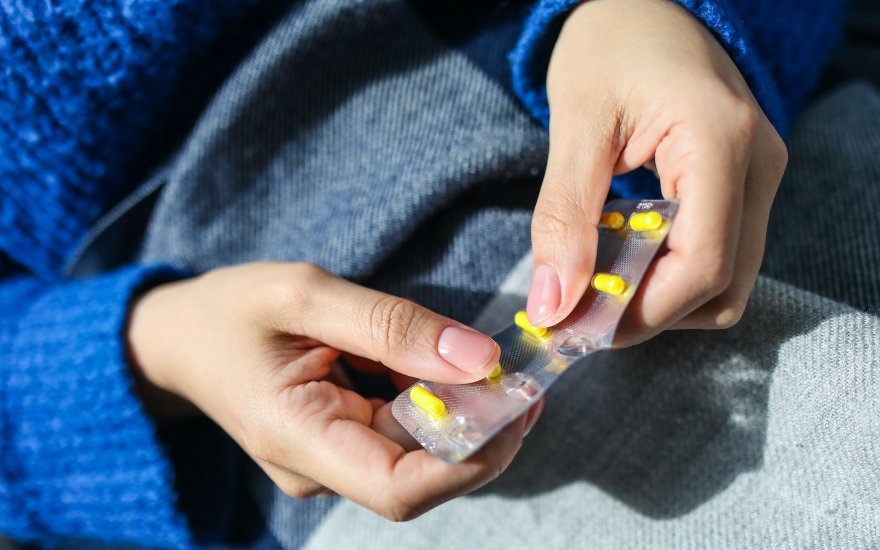
However, as with any nutrient, one should not overdo the intake of these metabolites: excessive consumption can cause effects opposite to those desired.
Read also: Diosmin against cellulite: here’s how the flavonoid may help reduce the problem
Contraindications and side effects
Although research on the side effects of flavonoids is very limited, it appears that excessive intake of these compounds has potentially negative effects.
At very high doses, bioflavonoids can inhibit certain enzymes essential for hormone metabolism and act as pro-oxidants (i.e. promote the generation of free radicals).
Particular care must also be taken during pregnancy, as these natural compounds cross the placenta with great ease.
Therefore, despite the fact that they are derived from plant substances, flavonoids supplements should always be taken under medical advice and supervision and after having carried out appropriate tests (a rule that applies to all food supplements).
Sources:
Panche AN, Diwan AD, Chandra SR. Flavonoids: an overview. J Nutr Sci. 2016 Dec 29;5:e47. doi: 10.1017/jns.2016.41. PMID: 28620474; PMCID: PMC5465813.
Skibola CF, Smith MT. Potential health impacts of excessive flavonoid intake. Free Radic Biol Med. 2000 Aug;29(3-4):375-83. doi: 10.1016/s0891-5849(00)00304-x. PMID: 11035267.
Serafini M, Peluso I, Raguzzini A. Flavonoids as anti-inflammatory agents. Proc Nutr Soc. 2010 Aug;69(3):273-8. doi: 10.1017/S002966511000162X. Epub 2010 Jun 23. PMID: 20569521.
Bai L, Li X, He L, Zheng Y, Lu H, Li J, Zhong L, Tong R, Jiang Z, Shi J, Li J. Antidiabetic Potential of Flavonoids from Traditional Chinese Medicine: A Review. Am J Chin Med. 2019;47(5):933-957. doi: 10.1142/S0192415X19500496. Epub 2019 Jun 27. PMID: 31248265.
Main image: Immagine di pikisuperstar on Freepik
Information and details on bioflavonoids and their intake Flavonoids, or bioflavonoids, are the key active ingredients of many microcirculation supplements and antioxidant products. These particular compounds of plant origin are isolated in order to exploit their beneficial properties for the human organism. In the course of this article, we will see what natural flavonoids are, […]
Here's how to take care of your dog's paw pads in case of dryness
Dry cracking dog pads are a fairly common condition, and action needs to be taken as quickly as possible to avoid infections, pain and even joint damage due to poor posture.
Pads, in fact, are a very important part of dogs' paws: they cushion shocks, allow the animal to sweat, help regulate body temperature and stay balanced.
Moreover, as they stand in close contact with surfaces, in addition to supporting the entire body of the dog, they must be in perfect health if we want to prevent our four-legged friends from experiencing discomfort and pain.
But why do dogs’ pads sometimes get dry? And which remedies should we take to treat this discomfort?
In this article we will explore the causes of cracked paw pads and see what the right remedies are according to the circumstances.
Read also: Does your dog have a dry, cracked nose? Let’s look at the causes, remedies and reasons for concern
Main causes of dry paw pads in dogs
Under normal conditions, the paw pads of dogs are soft, shiny and well moisturized thanks to the action of sweat glands. It may happen, however, that they become dehydrated with cracks appearing on their surface.
Here below, are the main causes of dry fingertips in dogs:
- Excessive heat: one of the main causes of cracked paws is the extremely hot ground temperature. It is therefore no coincidence that during the summer it is not advisable to walk dogs in the hottest hours of the day: your furry friends risk dangerous heat strokes, and their paw pads can get burned when coming into contact with the excessive heat of the asphalt pavements.
- Cold temperatures: just like the skin on our hands, the skin on dogs' paw pads is very sensitive to winter temperatures. If you don’t intervene in time, extreme cold can chap and crack your dog’s paws, hence causing very painful splits.
- Rubbing against rough surfaces: walking, running and jumping up and down in the countryside is usually much more fun for a dog than being kept indoors! But pay attention to paw care: a cream for the dog's fingertips is always recommended before and after outdoor outings.
- Allergic reactions: food or contact allergies may manifest themselves in cracking, swelling and itching of the dog’s paw pads (as well as of its nose and other skin areas).
- Hyperkeratosis: this is a disease that causes excess keratin; it makes the skin of the dog's fingertips and nose extremely rough and thicker than it should be. In this case, both the nose and the paws become very rough, hard and swollen.
- Dermatitis: (the most common types in dogs are interdigital dermatitis and pododermatitis), that manifests itself in dryness and cracking of the fingertips as well as other symptoms such as the appearance of scabs, ulcers, and papules.
- Nutritional deficiencies: nutritional deficits, and particularly zinc deficiency, can provoke extreme dehydration and thickening of the skin on dog paws. It is important to know that some dog breeds are particularly predisposed to zinc deficiency. The main ones among them are: Siberian Husky, Great Dane, Bull Terrier, Rhodesian Ridgeback, Labrador, German Shepherd, German Bracco, Doberman, Golden Retriever, Rottweiler and Beagle.
Let us now see what the remedies to cracked and dry fingertips in dogs may be.

Natural (and non-natural) remedies against dry paw pads
Chapped fingertips can cause great difficulties to dogs. It is therefore essential to take the correct steps and find the right remedies.
In case of dryness caused by external agents (too hot or too cold temperatures and rubbing against rough surfaces), it is usually sufficient to use a cream for the dog’s fingertips.
The ointment must be specifically suited to dogs and it must be as natural as possible to prevent them from getting intoxicated in case they licked their paws.
Prevention is also key. If you want to take care of your dog’s paw pads, here are the steps to follow:
- apply paw balm both before walks (so as to protect the fingertips from rubbing against the ground), and after returning home (to better moisturize the pads).
- In the summertime, avoid taking your dog for walks during the hottest hours of the day; the asphalt might be hot even in the evening, so prefer shaded areas.
- If winter is harsh and your dog has very delicate paws, try to persuade him to wear special booties or socks. Should he refuse, dry his paws right away once you get home and moisturize them with specific cream for paws.
On the other hand, pathologies such as allergic reactions, hyperkeratosis, dermatitis and nutrient deficiencies must necessarily be treated by the vet.
Distinguishing the problems is, in general, very simple. In cases of disease, dryness is accompanied by swelling, thickening of the skin, tearing, and itching. Instead, if the pads are simply dehydrated, all these symptoms should not manifest.
Here’s how to take care of your dog’s paw pads in case of dryness Dry cracking dog pads are a fairly common condition, and action needs to be taken as quickly as possible to avoid infections, pain and even joint damage due to poor posture. Pads, in fact, are a very important part of dogs’ […]
Useful information on hydrolyzed collagen and its intake
Collagen is the main protein that makes up human connective tissues, including skin, muscles, joints and tendons. Over time, however, the body reduces its production due to ageing and bad habits such as smoking, an unbalanced diet and many other factors.
To make up for the deficiency of this important substance, many people take hydrolyzed collagen in the form of antioxidant supplements, products that have become very popular in recent years, especially among women and sports people.
This article explains what hydrolyzed collagen is, how you should take it, and what its functions, benefits, and side effects are.
What is hydrolyzed collagen and how is it obtained?
Hydrolyzed collagen is the product obtained by subjecting collagen to the process of hydrolysis.
Hydrolysis allows collagen to be broken down into peptides, that is protein fragments with a lower molecular weight than its original form, in order to make it more easily digested and absorbed. In addition, this process has the ability to cancel or enhance the gelling power of the protein.
Generally, bovine collagen, porcine collagen, chicken collagen, or fish collagen (the so-called hydrolyzed marine collagen) are used to fine-tune the hydrolysis, according to the intended uses.
Plant collagen does not exist, so beware of those who promote certain products as "vegan or vegetarian collagen"! They are usually supplements with Vitamin C - a nutrient that contributes to normal collagen formation - but do not contain the protein.
Once hydrolyzed into peptides, collagen results:
- more soluble in water and other liquids
- easily absorbed in the intestines and skin
- easily digested
- more antioxidant
For all the aforesaid reasons, it is often used as an optimal ingredient in both cosmetics and pharmaceuticals.
In what products can collagen peptides be found?
In cosmetics, collagen peptides are commonly used in facial serums, face creams, and body creams thanks to their strong moisturizing action.
In pharmaceuticals, hydrolyzed collagen is used in the development of antioxidant supplements often combined with hyaluronic acid and vitamin C. Like collagen, hyaluronic acid accounts for a significant percentage of the connective tissue and has a powerful moisturizing action, while vitamin C plays a key role in the synthesis of collagen.
Collagen supplements to be taken orally (either in powder or capsules) are vastly used for the well-being of skin, bones, tendons, connective tissues, and joint cartilage.
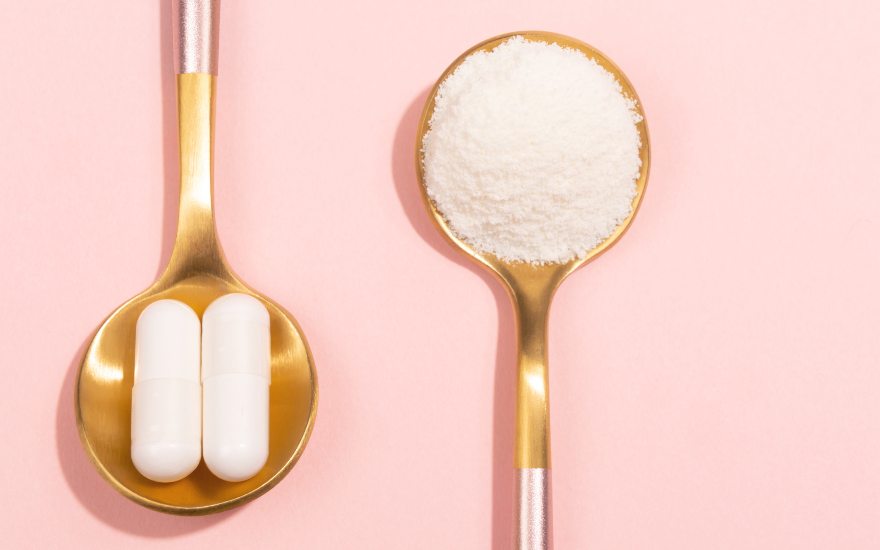
Although the human body contains about 30 different types of collagen (depending on the area of the body), the majority of products are based on collagen types I, II, and III.
Type I collagen supplements (of bovine, porcine, or marine origin) are more suitable for skin, bones, tendons, ligaments, teeth, and fibrous cartilage, including that of knee menisci.
Collagen type II (chicken or bovine or porcine cartilage) supplements are mainly recommended for joint health.
Products developed with type III collagen (bovine or porcine) are dedicated to the well-being of connective tissues, blood vessels, and the gut. In contrast, they are not very suitable for skin health, as this form of collagen makes up only 5 percent of the ageing adult skin. But what exactly is hydrolyzed collagen used for?
The many benefits of hydrolyzed collagen
According to the latest research, collagen supplementation helps slow down skin ageing, have a younger-looking skin, counter joint pain, improve lean mass, and strengthen muscles. In addition, hydrolyzed collagen promotes the synthesis of new collagen in the skin and joints.
Numerous studies have investigated the benefits of hydrolyzed collagen and explained how it can improve our health. Below are the many benefits highlighted by the various analyses.
Collagen for the skin
Collagen supplements are largely used as natural antioxidants to improve skin appearance, reduce signs of ageing, and accelerate skin healing.
In fact, as revealed by as many as 19 studies, people who had taken hydrolyzed collagen for 90 days experienced excellent results in terms of wrinkle reduction, hydration and skin elasticity compared to volunteers who had taken only a placebo product (source:https://www.ncbi.nlm.nih.gov/pmc/articles/PMC7070905/).
This phenomenon is partially explained by the fact that collagen peptide levels in the blood are usually very low. Once supplements are taken, the concentration of peptides in the blood increases.
Among them, Pro-Hyp (one of the main food-derived collagen peptides) increases the growth of fibroblasts. These, besides regulating tissue development and growth, promote the synthesis of hyaluronic acid, which in turn keeps the skin hydrated, soft and elastic.

Collagen for joints and bones
There are currently more than 60 research studies demonstrating the benefits of hydrolyzed collagen on joint cartilage, joint pain, and other conditions such as osteoarthritis, osteoporosis, and osteopenia.
Studies have shown that collagen (often combined with Vitamin D and calcium supplements in the case of bone diseases) helps improve bone metabolism and reduce joint pain, even in athletes.
In particular, type II collagen is the one indicated for bone and joint disorders, while type I collagen is particularly good for the well-being of the menisci (found in the knee, temporomandibular and acromioclavicular joints, wrists, and where the ribs join the vertebral transverse joints).
Collagen for muscles
Several studies have shown that supplementing 15 to 20 grams a day of hydrolyzed collagen, either in powder or capsule form, helps improve muscle mass and strength, even in the elderly.
Indeed, being a protein collagen proves very useful for both sports people and people who, due to age, experience a decline in muscle mass and tone.
In both cases, the nutrient supports the work done by resistance training, even though its action would be in vain without constant exercise.
Read also: Arnica: what is it, what is it used for and what are its properties?
Other benefits of hydrolyzed collagen: a win-win ingredient for your heart, hair and nails
Collagen is found in blood vessels and involuntary muscles, but it is still unclear whether supplementing it can improve the health of our cardiovascular system. As studies on this issue are still being carried out, a definite answer cannot yet be given. This applies to both hair and nails too, where the protein is also present.
However, there is scientific evidence (such as the study “ Oral supplementation with specific bioactive collagen peptides improves nail growth and reduces symptoms of brittle nails”) supporting the fact that taking collagen peptides can improve growth and reduce brittle nails.
Possible contraindications and side effects
As anticipated, hydrolyzed collagen supplements are of animal origin (mostly derived from cattle, fish, and poultry).
Due to this, anyone allergic to the meat of these animals may experience severe side effects encompassing facial and body swelling, hives, abdominal pain, respiratory problems, and anaphylactic shock.
Another common effect triggered by taking collagen powder is a sense of fullness, a feeling that is welcome for some and annoying for others.
Conclusions
To sum up: In addition to moisturizing your skin, hydrolyzed collagen supplements confer it a more youthful appearance, counter joint pain, and improve bone and muscle health.
The many studies conducted so far on the benefits provided by taking collagen supplements have led to excellent results.
Despite the favorable outlook, further research is needed to ensure the well-being of your heart, blood vessels and hair.
As for side the effects of hydrolyzed collagen, beware of food allergies! . Since it is an animal derivative, collagen intake should be avoided if you have developed allergies or intolerances to beef, fish, and chicken.
Sources
Aguirre-Cruz G, León-López A, Cruz-Gómez V, Jiménez-Alvarado R, Aguirre-Álvarez G. Collagen Hydrolysates for Skin Protection: Oral Administration and Topical Formulation. Antioxidants (Basel). 2020 Feb 22;9(2):181. doi: 10.3390/antiox9020181. PMID: 32098294; PMCID: PMC7070905.
León-López A, Morales-Peñaloza A, Martínez-Juárez VM, Vargas-Torres A, Zeugolis DI, Aguirre-Álvarez G. Hydrolyzed Collagen-Sources and Applications. Molecules. 2019 Nov 7;24(22):4031. doi: 10.3390/molecules24224031. PMID: 31703345; PMCID: PMC6891674.
de Miranda RB, Weimer P, Rossi RC. Effects of hydrolyzed collagen supplementation on skin aging: a systematic review and meta-analysis. Int J Dermatol. 2021 Dec;60(12):1449-1461. doi: 10.1111/ijd.15518. Epub 2021 Mar 20. PMID: 33742704.
Sato K. The presence of food-derived collagen peptides in human body-structure and biological activity. Food Funct. 2017 Dec 13;8(12):4325-4330. doi: 10.1039/c7fo01275f. PMID: 29114654.
Liu B, Xu Z, Yu R, Wang J, Wang Z, Harrell CR. The Use of Type I and Type III Injectable Human Collagen for Dermal Fill: 10 Years of Clinical Experience in China. Semin Plast Surg. 2005 Aug;19(3):241–50. doi: 10.1055/s-2005-919719. PMCID: PMC2884804.
Ohara H, Iida H, Ito K, Takeuchi Y, Nomura Y. Effects of Pro-Hyp, a collagen hydrolysate-derived peptide, on hyaluronic acid synthesis using in vitro cultured synovium cells and oral ingestion of collagen hydrolysates in a guinea pig model of osteoarthritis. Biosci Biotechnol Biochem. 2010;74(10):2096-9. doi: 10.1271/bbb.100193. Epub 2010 Oct 7. PMID: 20944430.
Useful information on hydrolyzed collagen and its intake Collagen is the main protein that makes up human connective tissues, including skin, muscles, joints and tendons. Over time, however, the body reduces its production due to ageing and bad habits such as smoking, an unbalanced diet and many other factors. To make up for the deficiency […]
Diosmin fights cellulite and water retention from within (as shown by research). Let's see how.
Cellulite is a disorder of the subcutaneous fatty tissue that manifests itself in a particularly hated blemish: orange peel skin.
Very often, problems with venous and lymphatic microcirculation are hidden behind this issue. Several studies conducted in this regard have highlighted how diosmin-rich microcirculation supplements may help fight cellulite.
In this article we will focus on diosmin and cellulite, explaining how the famous flavonoid can alleviate a problem affecting about 90% of women.
Cellulite: what is it and what are the causes of its onset
Cellulite is a degenerative disorder of the panniculus adiposus that manifests itself in the form of skin bumps, similar to holes.
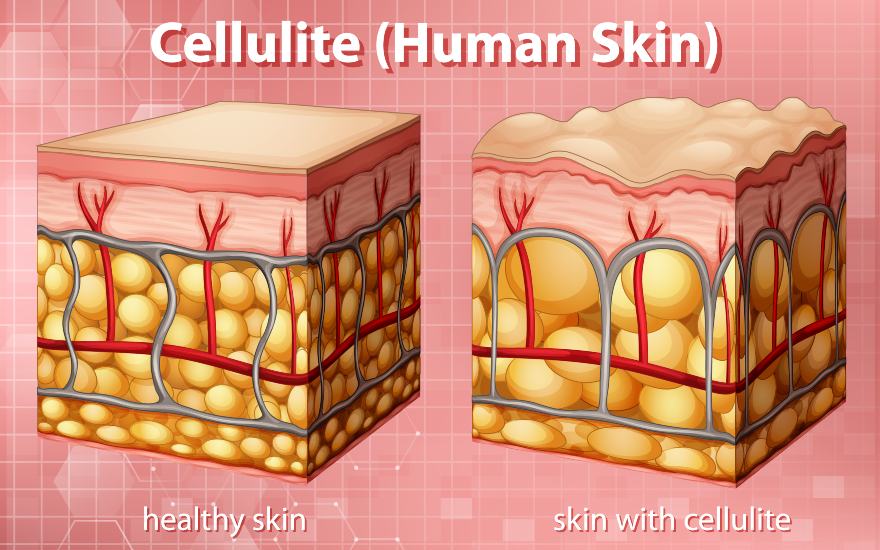
Lots of people believe that this problem is caused by a high percentage of body fat. Actually, its main trigger is a poor microcirculation function encompassed by hormonal, vascular and lymphatic changes.
Although they are not the main causes of this medical condition, other factors such as sedentariness and overweight can accelerate and worsen the appearance of blemishes (so much so that many women in perfect physical shape complain of that much-hated “orange peel skin”).
To combat cellulite, as well as other annoying problems such as water retention and fragile capillaries, it is therefore recommended to work on improving microcirculation.
Diosmin, a natural antioxidant compound belonging to the flavonoid class, seems to be the most suitable substance to help with this condition.
What is microcirculation?
Microcirculation is the circulation of blood in arterioles, metarterioles, capillaries, venules and blood vessels smaller than 200 microns in size.
Suffering from poor microcirculation is a fairly common medical problem that manifests itself, among others, in the following conditions:
- swollen, heavy and painful legs, especially at the end of the day
- edema, due to fluid accumulation in the lower and/or upper limbs
- cellulite and water retention
- varicose veins and fragile capillaries (often called "broken capillaries") on the legs
- cold hands and feet
- recurrent hemorrhoidal disorders
Taking diosmin has proven to exert a positive action on microcirculation and lymphatic circulation.
Diosmin: from nature to our body. It improves microcirculation and fights cellulite
The flavonoid called diosmin is a substance that exerts a beneficial action for human health; in nature, we find it in citrus fruits but also in some plants, such as Ruta graveolens and Barosma betulina.
With regard to microcirculation, it is renowned for its anti inflammatory, antioxidant and protective action, which is why, since the beginning of the 20th century, it has been extracted from plants and used to make food supplements and cosmetic products.
The beneficial action of diosmin on microcirculation also results in the reduction of cellulite blemishes and water retention.
In particular, one of the most in-depth studies on diosmin and cellulite (Purified diosmin, a valuable pharmacological aid in the topical treatment of cellulitis in combination with manual lymph drainage, hydroelectrophoresis and tecar therapy) was carried out at the Modica Division of Sports Medicine and Traumatology in Ragusa and published in 2006 in the Italian Medical Journal Archives for Medical Sciences.
Through this study, researchers wanted to determine whether taking diosmin could enhance the effects of topical cellulite treatments, such as manual lymphatic drainage.
The combined treatment led to the achievement of optimal results, measured by skin ultrasound at 2, 4 and 6 months following the start of the study.
The conclusions drawn by this research led to the following considerations: diosmin enhances the effectiveness of topical treatment through a systemic action on blood and lymphatic vessels by restoring the normal vascular physiology, and performing a topical action on those areas involved in the inflammatory process.
Another study ((Recurrent telangiectasias after capillary sclerotherapy in women with cellulitis and the preventive effects of Diosmin) conducted in 2007 on 30 women with moderately severe cellulitis, produced similarly favorable results. In fact, diosmin proved to be extremely effective in reactivating subcutaneous microcirculation and reabsorbing interstitial edema, i.e., fluid accumulation at the tissue level.
This result was evidenced by a reduction in thigh circumference and an increase in skin smoothness.

How to take diosmin against cellulite?
It is possible to take diosmin either through your daily diet – for instance, by increasing consumption of citrus fruits - or through microcirculation supplements that contain this active ingredient, often combined with hesperidin.
Diosmin supplements are often recommended by physicians when microcirculation problems are particularly evident (and, therefore, when the patient needs a large intake of this flavonoid to achieve a substantial improvement).
The daily dosage of diosmin ranges from 450 to 900 mg per day, depending on the severity of the situation, while the duration of treatment must be determined by your physician.
In addition, you can also find this flavonoid within products for skin use, such as gels and creams against cellulite and swollen legs.
Read also: Swollen legs: quick remedies to alleviate the discomfort
In conclusion
Diosmin has proved to be an effective ally in combating cellulite blemishes, as well as capillary fragility, leg heaviness, and many other problems related to poor microcirculation.
Of course, this flavonoid alone cannot work miracles. To reduce cellulite, it is also necessary to adopt an active lifestyle, perform manual treatments such as lymphatic drainage, hydroelectrophoresis, and tecar therapy, and avoid tight-fitting clothes, which prevent proper blood and lymphatic flow.
And, last but not least, both sport and an increase in muscle mass may contribute to make blemishes less visible.
Sources:
Rosa, M.. (2006). Purified diosmin, a valuable pharmacological aid in the topical treatment of cellulitis in combination with manual lymph drainage, hydroelectrophoresis and tecar therapy. Gazzetta Medica Italiana Archivio per le Scienze Mediche. 165. 73-78.
Perotti F. (2007). Recurrent telangiectasias after capillary sclerotherapy in women with cellulitis and the preventive effects of Diosmin. Gazzetta Medica Italiana Archivio per le Scienze Mediche 2007 October;166(5):157-62
https://www.medicalnewstoday.com/articles/149465 (Everything you need to know about cellulite)
https://www.scientificamerican.com (Is cellulite forever?, by Katherine Harmon)
Disclaimer: the information provided in this article represent general indications and in no way substitute medical advice.
Picture: Picture of brgfx on Freepik
Diosmin fights cellulite and water retention from within (as shown by research). Let’s see how. Cellulite is a disorder of the subcutaneous fatty tissue that manifests itself in a particularly hated blemish: orange peel skin. Very often, problems with venous and lymphatic microcirculation are hidden behind this issue. Several studies conducted in this regard have […]
Let’s see when it is safe to use arnica in pregnancy and when, instead, it is better to avoid it.
Pregnancy can bring many joys but also many pains, such as back pain, neck inflammation and cramps in different areas of the body. However, in order to protect the unborn child, doctors often advise against taking pain-relieving and anti-inflammatory drugs during pregnancy, or recommend limiting their use.
For this reason, it is not unusual for expectant mothers to favor natural remedies such as arnica-based products. But, can arnica be used during pregnancy? Are there any contraindications in its use or is it a safe plant for a pregnant woman?
This article will help you discover the benefits and possible side effects of using homeopathic products, creams and arnica gels during pregnancy, with a specific focus on breastfeeding, so that expectant mothers can be aware of when to avoid and when to use these natural remedies against pain and discomfort.
Which arnica-based products can be used during pregnancy?

Studies on the use of arnica extracts in pregnancy suggest that the products applied to the skin have a local (topical) effect and are therefore safe for the fetus.
According to these studies, pregnant women can use arnica gels, creams, oils, and ointments directly on the skin without any particular contraindications or side effects (except, of course, for any allergies to the plant or other components of the products).
Based on the same studies, the use of topical arnica products is generally safe even during breastfeeding.
Be careful, however: gels, creams and other products for skin use should not be applied to wounds, scratches and, generally, to injured skins.
Homeopathic remedies derived from arnica extracts are considered safe also for the fetus because the extracts of the plant are extremely diluted. Nevertheless, when ingested, arnica is potentially toxic to the body; it is therefore essential to consult your doctor before ingesting any medication made from the plant extracts.
And so, are there any particular cases when applying arnica to the skin may prove beneficial?
Back pain, neck pain and more: this is when arnica can prove to be a valuable aid for pregnant women
Arnica flowers are rich in flavonoids, triterpenes, sesquiterpene lactones and many other substances beneficial to the human body.
These active ingredients perform several functions as they have an anti-inflammatory, anti-edematous, analgesic, and revulsive (i.e., stimulating circulation in the superficial skin layers) effect.
Carrying out massages with arnica products for skin use is therefore very useful against discomforts that often occur during pregnancy, such as for instance:
- lower back pain and, more generally, back pain
- localized pain in the region of the sacrum
- discomfort and twinges in the shoulder blade area
- neck pain (cervicalgia)
- carpal tunnel syndrome
- intercostal pain
- pain in the hips, ankles and knees
These problems are usually due to normal weight gain during the months of gestation, continuous stresses on the spine, shifting of the center of gravity, and, more generally, changes in pregnant women’s bodies.

Tip: to counteract the joint pain that arises during gestation, devil’s claw creams or gels may also prove useful.
Let us now focus on which arnica preparations would be best not to use during pregnancy and breastfeeding.
Arnica products to be avoided during pregnancy and breastfeeding
If not properly diluted, essential oils and extracts of arnica montana are potentially toxic to the body.
During pregnancy, but also under ordinary conditions, one should never take herbal teas or other “do-it-yourself” preparations containing arnica as these may cause a serious intoxication of both the mother and the unborn child.
Special caution is also required when ingesting arnica orally during breastfeeding.
Scientific literature in this regard is very scarce but an interesting report on a rather worrisome case deserves special attention: a just 9 days old infant developed haemolythic anemia 48 hours after his mother began drinking arnica flower tea.
The baby's total bilirubin amount was 41 mg/dL, with direct bilirubin levels of 5 mg/dL and hemoglobin levels of 5 g/L. Before this event, the child was healthy and the glucose-6-phosphate dehydrogenase (G6PD) status was normal.
After a targeted therapy, bilirubin levels decreased to 9.9 mg/dL. The mother stopped drinking arnica tea and resumed breastfeeding without the baby experiencing further haemolysis (the process of red blood cell destruction). The hospital staff hence deduced that the infant's hemolytic crisis had probably been caused by arnica tea. (here, at point 120 of the page, you can view the entire report)
This is so far the only report of arnica side effects due to the passage of the active ingredients through breastmilk. However, great caution should always be exercised.
Final Conclusions
Arnica is an excellent plant for combating muscle and joint pain; it is found commercially in the form of products for skin use and homeopathic medicines.
Studies on the plant suggest that it is possible to use arnica cream, oil, or gel during pregnancy to get relief from discomfort.
Before taking homeopathic medicines based on this natural product, however, you should contact your doctor for advice.
Absolute ban on taking home extracts and “do-it-yourself” remedies based on arnica which,-if not diluted in the correct amounts,-can cause intoxication and other serious problems for both the mother and the unborn child (probably, also the breastfed one).
Sources:
Smith AG, Miles VN, Holmes DT, Chen X, Lei W. Clinical Trials, Potential Mechanisms, and Adverse Effects of Arnica as an Adjunct Medication for Pain Management. Medicines (Basel). 2021 Oct 9;8(10):58. doi: 10.3390/medicines8100058. PMID: 34677487; PMCID: PMC8537440.
Drugs and Lactation Database (LactMed) [Internet]. Bethesda (MD): National Library of Medicine (US); 2006-. Arnica. [Updated 2021 May 17]. Available from: https://www.ncbi.nlm.nih.gov/books/NBK501828/
Miller, A. & Ly, B. & Clark, R.. (2009). Neonatal Hemolysis Associated with Nursing Mother Ingestion of Arnica Tea. Clinical Toxicology. 47. 726-726.
Miller AD, Ly BT, Clark RF., University of California San Diego Medical Center, San Diego, CA, USA; VA San Diego Healthcare System, La Jolla, CA, USA. Neonatal Hemolysis Associated with Nursing Mother Ingestion of Arnica Tea
Let’s see when it is safe to use arnica in pregnancy and when, instead, it is better to avoid it. Pregnancy can bring many joys but also many pains, such as back pain, neck inflammation and cramps in different areas of the body. However, in order to protect the unborn child, doctors often advise against […]
Tattoo aftercare tips and instructions
Moisturizing a new tattoo is extremely important to promote optimal healing of the skin, maintain brilliant colors and prevent scars that would spoil al the work done.
After choosing a good tattoo cream, you must apply it regularly until complete recovery as the skin should never dry out. However, you may be wondering, how long should I put the cream on my new tattoo?
Along with some useful tips on the healing of your newly tattooed skin, in this article you will find an answer to the following questions: “When should I apply the cream? How many times a day, and for how many days?”
Tattoo cream: how many days you need to apply it for optimal skin healing
After getting a tattoo, you should moisturize it daily for at least 10 to 14 days. Respecting these timeframes is absolutely crucial because, if your skin dries out, you are likely to get very disappointing results.
What would happen if I didn't use a post-tattoo butter or cream (or, if I used a product unsuitable for the care of a new tattoo)?
Faded and uneven colors, irritation and inflammation could be some of the consequences.
Don't be afraid to moisturize your skin for too many days: there is usually no time limit within which you should stop using tattooed skin care products.
Unless it is a poor quality product that causes irritation and rashes on the skin (in which case we advise you to stop using it), you can go on applying the same cream even after healing is complete, using it as a maintenance product.
Not sure which product to choose to take care of your new tattoo?
Find the answer here: Which cream to use on tattoos to promote perfect healing
How many times a day should I put cream on my new tattoo?
Now that we have seen how many days you need to put cream on your new tattoo, let's go into a little more detail: how many times a day should you moisturize your newly tattooed skin?
Usually, we recommend washing the tattoo and applying a soothing cream 2 to 4 times a day immediately afterwards, depending on your skin type.
For example, if your skin dries out quickly, the number of applications will probably be closer to 4 than to 2, especially during the first week (when the skin is still traumatized and may feel tight).
The layer of cream or tattoo butter you apply must be thin, so as not to suffocate the skin and promote complete healing.
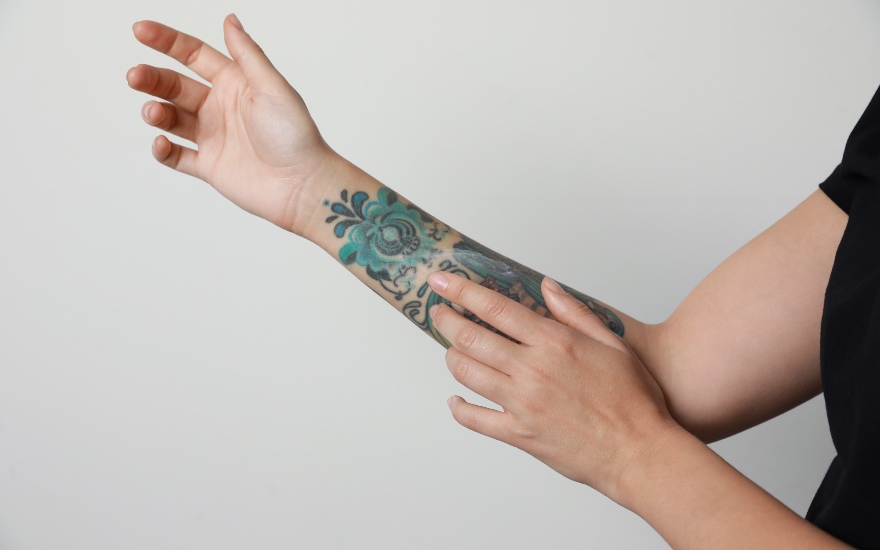
How can I tell if the newly tattooed skin has healed?
A few days after tattooing, scabs, usually the same color of ink, begin to form on the skin and the treated area may even peel and itch considerably.
Nothing to worry about, because this is the usual healing process! Take care, however, never to remove the tattoo scabs prematurely or scratch the skin. You would risk ruining your tattoo and having to retouch it.
Only when the skin stops flaking and peeling, you can consider it completely healed.
If you have any doubts and do not want to risk making a mistake, we recommend you to:
- contact the tattoo artist who did the work and seek advice, or
- continue moisturizing the tattooed skin for another week to make sure it is 100% healed
In any case, it is very rare for a tattoo to heal in less than 10 days: keep this in mind! Don't be in a rush to speed up healing and give your skin plenty of time to recover.
Other useful tips for the care of your new tattoo
The healing process of a tattoo can be a cause for concern even for veterans, because the skin does not always recover in the same timeframe.
The duration of the healing process depends on many factors, including your skin and body health, the type of ink used, the area where the tattoo was done and much more.
However, we have prepared a list of recommendations that you can print yourself well in mind (so as to avoid big mistakes). Here they are:
- Once the job is done, the tattoo artist applies a moisturizing product, usually vaseline, to the area and protects the skin with a layer of transparent film. When, after a few hours, you remove the bandage to wash the skin and spread the panthenol cream, do not apply the film again! Tattooed skin needs to breathe in order to heal best.
- Wash the tattoo with lukewarm water and a specific soap (or neutral soap). Dry the area by dabbing, without rubbing, using blotting paper or a clean towel.
- The area must always be moisturized: apply a thin layer of tattoo cream 2 to 4 times a day for at least 10 to 14 days (warning: the product must be specifically designed for tattooed skins and is not a simple moisturizer - read here why).
- In the healing phase you may feel a lot of itching, and scabs will form on the tattooed area. As this is normal, do not scratch the skin! The scabs must fall off by themselves.
- If something unexpected happens - e.g. inflammation or unexpected blisters on the tattoo – immediately contact the professional who did the work so that he/she can give you the right advice. If, instead, you notice allergic reactions to the ink, promptly ask for medical advice.
- If the new tattoo comes into contact with clothes, prefer natural breathable fabrics, such as cotton.
- Wash your hands well before touching the healing skin to avoid infections.
- Until the tattoo has healed, avoid high bacterial environments (swimming pools, saunas, beaches, etc.), as well as tanning lamps and exposure of the tattooed area to the sun.
- Do not use disinfectants, cortisone, antibiotic or healing creams (e.g. Gentalyn Beta and Cicatrene) on the newly tattooed area. In case of bacterial infection, consult your doctor and follow his/her specific advice.
- After the tattoo has healed, you can expose the area to the sun, provided that you always use a SPF 100 or SPF 50 sunscreen.
And remember: if you have any doubts, do not hesitate to contact the professional who did the tattoo!
Tattoo aftercare tips and instructions Moisturizing a new tattoo is extremely important to promote optimal healing of the skin, maintain brilliant colors and prevent scars that would spoil al the work done. After choosing a good tattoo cream, you must apply it regularly until complete recovery as the skin should never dry out. However, you […]
Tips to deflate legs quickly and effectively
Leg swelling is a condition that affects many people, women in particular. It is often accompanied by slight pain (especially at the end of the day) and by a strong sensation of heaviness.
Triggering factors can be many; among the most common ones are sedentary work, lack of physical exercise, illness, pregnancy and circulatory problems.
What can you do to find quick relief?
In this article, we will outline the quickest remedy actions against swollen legs, which will have to be repeated on a daily basis in order to obtain constant benefits.
However, the problem of swollen, heavy legs, which may also lead to more complex conditions, such as oedema, should not be underestimated. Only a doctor can thoroughly investigate both its causes and possible solutions.
1. When taking a shower, direct jets of cold water at your legs
The first tip against swollen legs is to expose your legs to jets of cold water, preferably alternating them with jets of warm water.
This helps improve microcirculation (i.e. blood circulation in the capillaries, arterioles, metarterioles, venules and lymphatic capillaries).
In addition to this, cold induces a temporary reduction in pain and an immediate vasoconstrictor effect, i.e. a decrease in the volume of blood vessels.
For the above reasons, cold water jets make the legs lighter and promptly reduce soreness.
2. Use a refreshing leg cream to immediately relieve swelling

Using a cold-effect leg cream helps counteract swollen legs just like using cold water jets, as both methods are based on the same principle.
For an even more intense action, we recommend storing the cream in the refrigerator and choosing a product based on flavonoids, such as diosmin and centella asiatica.
Flavonoids, or bioflavonoids, are natural compounds found in many fruits, vegetables and certain plants. They exert considerable beneficial effects on the body, including an antioxidant, protective and strengthening action on microcirculation.
In particular, the flavonoids mentioned above have proved to be particularly suitable for microcirculation and lymphatic circulation; they also seem to act when applied directly to the skin.
A cream rich in diosmin and centella asiatica, preferably with a refreshing action, can therefore significantly help in the case of swollen legs.
3. Regular use of compression stockings
Compression stockings and tights exert pressure on the entire leg, usually from the bottom upwards. This promotes proper circulation and provides relief from heaviness, swelling and soreness.
We are however not referring to anti-thrombosis stockings - quite difficult medical devices to wear -but rather to compression stockings, which can be found online, at the supermarket or in intimate clothing shops.
4. Sleeping with your legs slightly raised
Another method of promoting circulation in the legs and, consequently, preventing or limiting swelling, is to sleep with the lower limbs slightly raised in relation to the trunk (about 15-20 cm).
This method can reduce venous and lymphatic stasis and facilitate blood flow.
Be careful, however: it is better not to place a pillow under the feet because leaving the knee hanging could impede blood flow.
The ideal is to place the pillow or another object under the mattress, so as to create an inclined plane, or use a pillow specifically designed for leg circulation, which gives support from the heel to the lower thigh
5. Favoring foods rich in draining substances that can help microcirculation

Compared to the other remedies against swollen legs, this might seem a slow- acting cream but, as a matter of fact, by improving your diet you will observe benefits even after just a few days.
In particular, here below are the foods specifically recommended for swollen and heavy legs:
- Vegetables, especially peppers, onions, radishes, celery, tomatoes, pumpkin and carrots as they are rich in substances beneficial to microcirculation (including flavonoids, Vitamin C and other antioxidants);
- Fresh fruit, favoring those rich in antioxidants (such as red or purple colored fruits, e.g. strawberries, blackberries and other berries),Vitamin C (e.g. citrus fruits and kiwi). Pineapple can also prove very useful as it is rich in bromelain, an enzyme that has a strong draining power;
- Dried fruits and seeds (sources of Omega-3), essential fatty acids with vasodilating action and beneficial for the microcirculation;
- Fish, also rich in Omeg-3.
In addition to the above, it is highly recommended to drink between 1.5 and 2 liters of water a day so as to prevent the accumulation of fluids.
In addition to the quickest remedies against swollen legs, here below are further tips to prevent or limit this condition.
Other useful tips to combat swollen legs
Although less immediate than those outlined above, here are a few more methods that may prove effective against leg swelling.
- Do sport constantly, privileging water disciplines. By exerting a light pressure on the legs, water can be extremely helpful for microcirculation.
- Avoid tight clothing, which can obstruct blood flow.
- Do not cross your legs, which is bad for your circulation.
- If you do sedentary work, take short breaks (if possible) and have a short walk. Even a phone call can be the perfect time to take a short walk.
- Add walking to your daily routine.
- Consider taking flavonoid supplements (only after medical approval).
- If possible, indulge in lymph drainage massages.
- Walk with your legs immersed in water (in the pool or at the beach), taking advantage of the summer period. Remember that summer is the most critical period for swollen and heavy legs .
Adopting these behaviors helps reduce the discomfort of swollen legs and provides relief both immediately and in the long term.
Of course, if the problem becomes unbearable or if varicose veins, oedema or other manifestations of poor circulation begins to occur, it is advisable to see your doctor for a thorough consultation.
This article outlines a wide range of methods to get quick relief from swelling. However, in some cases, the advice of a professional doctor may prove more than necessary.
Sources:
https://en.wikipedia.org/wiki/Microcirculation
https://www.medicalnewstoday.com/articles/327461
https://www.healthline.com/nutrition/foods-that-increase-blood-flow
Disclaimer: The information provided in this article represents general indications and in no way replaces medical advice.
Tips to deflate legs quickly and effectively Leg swelling is a condition that affects many people, women in particular. It is often accompanied by slight pain (especially at the end of the day) and by a strong sensation of heaviness. Triggering factors can be many; among the most common ones are sedentary work, lack of […]
Why has your dog got a dry nose and in which cases may this be considered an indicator of a disease
It is commonly known that the nose of a healthy dog should be moist and hydrated, while a dry nose may be a clear symptom of a disease, such as the much dreaded Leishmaniasis.
Actually (and fortunately), dryness and dehydration of the so-called 'truffle' are not always a sign of a health problem but, rather, an indication of something much simpler and solvable.
One thing is certain: a dry nose, which cracks very easily, can become a major problem for our four-legged friends.
Causes of a dry nose in dogs

A dog's nose is moist because it is covered with a thin layer of mucus, which helps the animal to smell. The truffle is often very wet: in fact, dogs do not have sweat glands like us, but sweat from their noses and paw pads.
As a rule, the so-called 'truffle' should always be moist, although certain situations may cause it to dry out. Some are worrying, others much less so.
Here are the most common causes of a dry nose in dogs:
- the cold: just like our skin, dogs' skin can also suffer from low temperatures and temperature changes, and crack as a result. The skin of the animal's nose and pads is the most exposed to cold and frost. It is therefore no coincidence that vets often recommend the use of a dog’s nose balm during the winter period;
- heat and dehydration: dogs' noses can become chapped and dehydrated due to high temperatures (not only in the summer months but also in the winter, due to heating, low humidity levels and exposure to the sun;
- Allergies: animals can suffer from allergies, including contact allergies, which can manifest themselves in the form of rashes both on the nose and on other parts of the body;
- Older age: some older dogs tend to have dry skin and develop dermatitis much more easily than younger individuals;
- Genetic predisposition: some dog breeds are predisposed to having a dry nose. In particular, it is brachycephalic dogs (i.e. with a skull that is more developed in width than in length) that are more prone to nasal problems, e.g. narrower-than-normal nostrils, dermatitis and breathing difficulties, which also lead to dehydration and cracking of the nose. Among the most common brachycephalic breeds are French Bulldogs, English Bulldogs, Pugs, Boxers, the Pekingese, the Cavalier King Charles Spaniel, the Shar-pei, the Dogue de Bordeaux, the Bullmastiff and many others;
- Diseases and deficiencies: - diseases and deficiencies: hyperkeratosis, zinc deficiency, autoimmune diseases, distemper, leishmaniasis and other disorders can also manifest themselves in the thickening of the nose skin.
That said, if your dog has a dry nose try to remember how long he has had this problem for? A few hours? A few days? A few weeks? Has he spent time in the sun or near a heat source, such as a heater?
Has he taken a walk in the winter cold?
Hasn’t he had a drink for a few hours?
Often, the cause of a dry nose is nothing really worrying, but rather a temporary and easily solved condition. There are cases, however, when it would be better to take your four-legged friend to the vet.

When should we worry if our dog has a dry nose?
Dry skin on the nose may not be a problem if it is the only symptom your dog is showing or if the condition disappears in a short time.
If, however, your dog shows symptoms of discomfort (such as tiredness and lack of appetite), or has cracked skin elsewhere on the body, then it would be best to take him to the vet for a consultation.
To dispel some of your doubts and, hopefully, also some of your worries, here are the main symptoms of the canine diseases mentioned above, which can lead - but are not limited to - a chapped nose:
- hyperkeratosis: this condition often affects both the nose and the fingertips and manifests itself in a severe thickening of the skin (which also leads to cracking and other problems). The skin of the nose is therefore both dry and much thicker than normal;
- zinc deficiency: visible symptoms of zinc deficiency include diarrhea, lack of appetite, hair loss, dermatitis on the nose, mouth, around the eyes and fingertips, and convulsions. Other symptoms, only detectable after a veterinary examination, are thyroid gland dysfunctions and renal, hepatic and cardiac insufficiency;
- autoimmune diseases: among the most frequent symptoms of autoimmune diseases in dogs there is a medical condition known as lethargy, which encompasses lack of energy and appetite, weight loss, diarrhea, skin ulcers and scaling on the nose, ears, mouth and paws;
- distemper: in addition to dermatitis on the nose and other parts of the body, distemper can manifest itself with lack of appetite, fever, vomiting, diarrhea, coughing (and other respiratory problems), weight loss, tremors and much more;
- leishmaniasis: the most frequent symptoms of leishmaniasis are severe tiredness, swollen joints, abnormal nail growth, lack of appetite, weight loss, eye problems (including conjunctivitis and retinitis), nosebleeds, dermatitis and hyperkeratosis concentrated on the dog's nose and fingertips.
Does your dog present any of these symptoms or, more generally, does his dry nose seem a rather strange condition to you? If so, we advise you to see your vet or veterinary surgeon to get their opinion and, if required, schedule some tests.
If, on the other hand, the dry nose is just temporary or genetic condition, then you can do something to relieve your four-legged friend.
Natural remedies for your dog's dry nose
If your dog is predisposed to truffle dryness or has been affected by high/low temperatures, you can adopt specific behaviors that can help him:
- To provide your dog immediate relief, moisturise his nose using a specific product, such as Dulàc Dog Nose Balm. Caution: do not use creams for human use, as dogs lick their noses and could ingest potentially harmful products. Specific products contain natural ingredients that are non-toxic to pets;
- protect your four-legged friend's skin with sunscreen before summer walks;
- use a moisturising cream or butter specifically developed for dogs' noses after walks, paying particular attention during summer and winter. In this connection, we recommend that you also moisturise your dog’s the fingertips (which, like the nose, may be affected by changes in temperature) with Dulàc Paw Balm;
- use steel bowls, which can be easily washed, so as to avoid bacterial proliferation and possible allergies from contact with plastic;
- make sure that your dog drinks enough, especially during the summer period, and always has fresh water available.
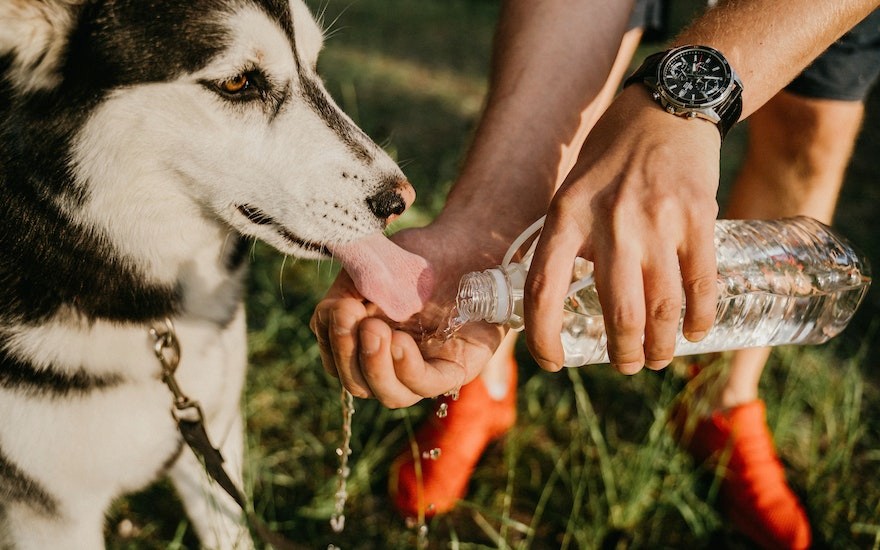
Conclusions
A dog's chapped nose, or simply a dry nose, can depend on numerous factors.
Very often it is a temporary but potentially annoying condition. It can therefore be treated by using a specific moisturising cream and taking appropriate measures.
If accompanied by other symptoms, such as debilitation and lack of appetite, dryness of the nose could be a sign of a canine disease.
Only a veterinary doctor can best analyze the situation: if you have any doubts, consult him without fear of overdoing it!
Sources:
Kokocińska-Kusiak A, Woszczyło M, Zybala M, Maciocha J, Barłowska K, Dzięcioł M. Canine Olfaction: Physiology, Behavior, and Possibilities for Practical Applications. Animals (Basel). 2021 Aug 21;11(8):2463. doi: 10.3390/ani11082463. PMID: 34438920; PMCID: PMC8388720
https://www.gruppoleishmania.org/en
https://vcahospitals.com/know-your-pet/why-do-dogs-have-wet-noses
Disclaimer: the information provided in this article represents general indications and in no way replaces medical advice.
Why has your dog got a dry nose and in which cases may this be considered an indicator of a disease It is commonly known that the nose of a healthy dog should be moist and hydrated, while a dry nose may be a clear symptom of a disease, such as the much dreaded Leishmaniasis. […]
What cream should we put on tattoos and how should we choose the right one? Here is the answer.
Are you about to get a new tattoo, or your first one ever, and would like to take the best care of it in order to facilitate the healing process of your skin? Then you are probably wondering which cream to put on your tattoos and how to choose the best one among the many available on the market.
Getting information in good time and avoiding making a hasty choice is a really good idea: you are giving yourself the opportunity to use the ideal product for your skin and to buy the right cream straight away, without having to change it in the process.
Today we want to resolve all your doubts and help you in this decision. We will talk about ingredients, density and, more generally, the requirements that a good cream for tattoos should have, so that you can confidently choose the one that best suits your needs.
The characteristics of a good post-tattoo cream
Using the right product for a newly tattooed skin is essential to preserve the colour of the ink and the integrity of the lines, so as to avoid discoloured parts of the tattoo and achieve a perfect final result.
Although the work of the tattoo artist is indeed essential, extreme attention must be paid to the skin care products to be used (and to how we use them) so as to prevent the risk of nullifying the efforts of the professional artist.
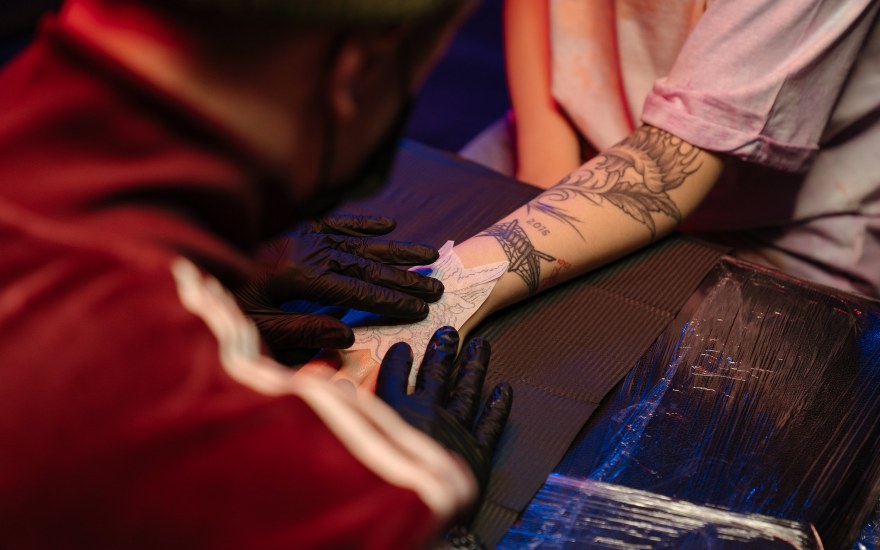
But what are the peculiarities of a good cream to use on tattoos?
Here are the main characteristics you should focus on:
- Ingredients: A good tattoo cream is rich in moisturising, soothing and protective agents (preferably of plant origin, as these provide nourishment and act as a barrier without hindering natural perspiration). A key component among these is panthenol, a regenerating, moisturising and elasticising ingredient for the skin.
- Density of the product: The ideal consistency of creams and butters for new tattoos is not too pasty. The product must spread easily without causing friction.
Another no less important feature is that the product you decide to use should be specific for tattoo care, in that it must be purposely formulated to best protect the affected area while avoiding infections and dryness.
Never use face creams, body creams, pure shea butter or other non-dedicated products, because you could compromise the final result.
In order to help you make an informed choice regarding which cream to use for tattoos, let’s now focus on the following points in more details.
The importance of active ingredients for tattoo healing
As mentioned above, tattoo products should always contain moisturising, soothing and, above all, barrier ingredients. In the healing phase, in fact, it is very important that the skin is protected from external agents and that it loses very little liquid, remaining well nourished and elastic.
Caution: never allow freshly tattooed skin to dry out. The final result could be irreparably affected (unless you have it re-tattoed).
You can check the cream formulations in the list of cosmetic ingredients (INCI), which is mandatory on the label.
This list is ordered according to the percentage of the substance present in the product: starting with the component present in the largest quantity down to the ingredient present in the smallest one.
But which ones should be preferred?
Here are a few examples:
- panthenol, regenerating and extremely moisturising. It should never be missing in creams for tattoos;
- shea butter: forms a breathable barrier on the tattoo, nourishes and provides elasticity to the skin;
- vegetable oils, such as olive oil and wheat germ oil: deeply moisturise and keep the skin well hydrated for a long time;
- aloe vera, calendula or other natural soothing ingredients: exceptional for relieving reddened and sensitive skin.
It is also key to choose substances able to prevent moisture loss as much as possible and form a protective layer on the affected area.
These components do not need to be of vegetable origin - it is very difficult to find a 100% natural cosmetic product, although some creams come very close to this rate; however, it is essential that they perform the above-mentioned action.
Among these, the most suitable for post-tattoo products are beeswax, liquid paraffin and vaseline (although the consistency of the latter is usually not well tolerated by people).
Liquid paraffin: is it really to be avoided in a tattoo ointment?
The reason for the presence of paraffin in many tattoo products is due to the fact that it creates a barrier on the skin, maintains hydration for a long time and prevents the penetration of external agents.
So, if scrolling through the list of ingredients you find a substance indicated as Paraffinum Liquidum, don't worry: it makes perfect sense!
Unless you suffer from an allergy to this ingredient, its presence, especially in small quantities, should not be a problem. Despite being demonised, it is necessary to stick to the facts: dedicated scientific studies have shown that this mineral oil is a lipophilic substance that does not penetrate human skin.
It simply prevents dehydration to the full, which is why it is so common in tattoo care products.
Furthermore, mineral oils are only allowed in cosmetics if they meet the purity specifications and safety requirements set by the European Pharmacopoeia and the EU Cosmetics Regulation EC/1223/2009.
In the light of the above, they must undergo a refining process aimed at eliminating any potentially carcinogenic substance.
Of course, especially to allow the proper transpiration of the skin, occlusive ingredients such as paraffin (i.e. that do not bind to the hydrolipid film of the skin, but form an additional barrier by reducing the evaporation of skin fluids) should be present in low quantities and combined with non-occlusive and potentially natural ingredients.
The consistency of the product, which is so important to obtain an excellent final result, depends on the formulation of the cream and on the right balance between ingredients.
The ideal consistency of a tattoo care cream
During the healing phase the formation of small scabs on the surface of the tattooed area may occur, often accompanied by an itching sensation and the colour of the tattoo being less bright than in previous days.
Such scabs should fall off from the skin by themselves. Tattoo artists recommend drying the tattoo by dabbing it with paper or a clean towel but never by rubbing. Moreover, you should be careful not to peel off the scabs when cleansing the skin and applying the cream.
For this reason, it is preferable to choose a fluid cream that spreads easily and evenly without causing too much friction. Pasty ointments should be avoided, as they generate resistance and can induce premature scab detachment.
Besides, depending on density, ease of spreading and other characteristics, you may prefer a tattoo balm to a cream.
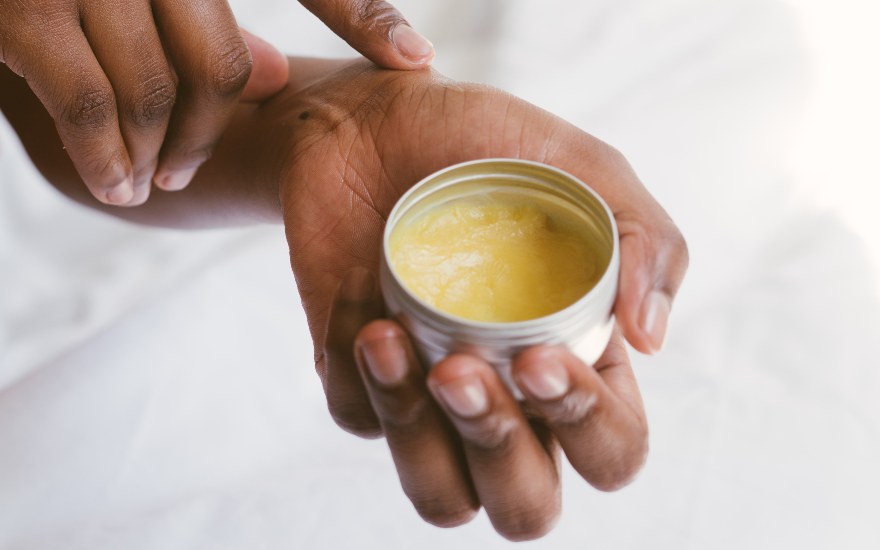
Knowing the texture of a product before using it may be difficult, but not impossible: there are plenty of product reviews online, and often those who have used a cream write a feedback on its fluidity and ease of application.
In conclusion
After getting a tattoo, the care product accompanies you for about two weeks and, more generally, until the skin is completely healed (which usually coincides with the detachment of the last scabs).
The cream, which is to be spread several times a day, must play some key roles such as:
- moisturise for a long time,
- promote perfect skin healing,
- protect the skin from external agents and dehydration by forming a protective barrier,
- relieve the dermis traumatised by needles.
A simple moisturising face or body cream is not enough. Choose a product specifically developed for your newly made tattoo, such as Dulàc Farmaceutici Panthenol tattoo cream, read the reviews and keep in mind what you have read in this article.
You have all the tools to make an informed choice.
What cream should we put on tattoos and how should we choose the right one? Here is the answer. Are you about to get a new tattoo, or your first one ever, and would like to take the best care of it in order to facilitate the healing process of your skin? Then you are […]